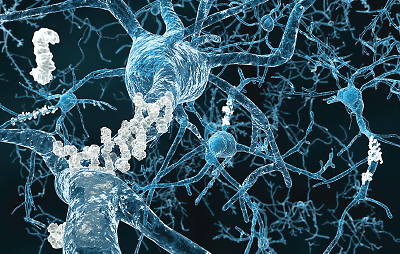Artery Stiffness Linked With Amyloid Plaques in Brain
Abstract
Consistent and long-term treatment of high blood pressure may blunt the progression of arterial stiffness and perhaps prevent deposition of beta-amyloid in the brain.
Recent studies have shown that more than half of individuals aged 80 or older have significant amounts of beta-amyloid plaques—a hallmark of Alzheimer’s disease—in their brains. Yet with the exception of the presence of the APOE-e4 gene variant, the reasons why beta-amyloid plaques accumulate in the brains of older people are not well understood.
Some research has suggested, however, that the stiffness of arteries in the body—a sign of subclinical vascular disease—might play a role in the plaque deposits. So Timothy Hughes, Ph.D., and colleagues at the University of Pittsburgh conducted a longitudinal study to determine whether there might be an association between the degree of arterial stiffness in the body and the accumulation of beta-amyloid in the brains of older people.

Their study included 81 individuals aged 83 or older and lasted two years. Arterial stiffness was measured with a noninvasive method called pulse-wave velocity. Brain levels of beta-amyloid were detected with PET scans, both at baseline and at follow-up.
As the researchers reported March 31 in JAMA Neurology, the proportion of beta-amyloid-positive individuals increased from 48 percent at baseline to 75 percent at follow-up. Moreover, even when some possible confounders were considered, each standard-deviation increase in arterial stiffness was associated with a fourfold increase in the odds of being beta-amyloid-positive at follow-up. Furthermore, arterial stiffness in the subjects was strongly associated with the amount of beta-amyloid deposited in their brains at follow-up.
Thus “arterial stiffness is a strong indicator of the extent of beta-amyloid deposition and its longitudinal accumulation over time,” the researchers concluded.
Although the exact mechanisms linking arterial stiffness and beta-amyloid deposition are unknown, the researchers suggested potential explanations. For example, “It is possible that increased arterial stiffening has a direct influence on penetrating arterioles of the brain, leading to altered structure and function, with subsequent effects on beta-amyloid clearance from the brain via cerebrospinal fluid drainage along the perivascular space.”
“Even at this early stage, these findings have clinical relevance for several reasons,” Hughes, who is now a postdoctoral scholar at Wake Forest School of Medicine, told Psychiatric News. “First, this and other recent studies suggest that amyloid plaque formation appears to be part of the aging process (shared with Alzheimer’s disease). . . . Second, arterial stiffness measured by pulse-wave velocity is a strong predictor of the extent. . .and progression. . .of brain amyloid; yet blood pressure alone is not informative,” he pointed out. “Neurologists, psychiatrists, or other clinicians aren’t going to rush out and get pulse-wave analyzers like those used in our study. However, they can appreciate that controlling factors that contribute to arterial stiffness may also be important for the brain. These include longstanding hypertension, insulin resistance, dyslipidemia, and atherosclerosis. They are already established risk factors for Alzheimer’s. . . .” He emphasized that, “Consistent and long-term treatment with antihypertensives, as soon as hypertension is detected, may blunt the progression of arterial stiffness. Future research will tell if this approach can also prevent the deposition of brain amyloid.”
The research was funded by the National Institutes of Health. ■
An abstract of “Arterial Stiffness and Beta-Amyloid Progression in Nondemented Elderly Adults” can be accessed here.



